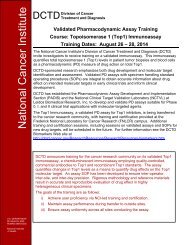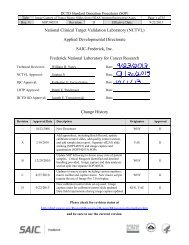National Cancer Institute - NCI Division of Cancer Treatment and ...
National Cancer Institute - NCI Division of Cancer Treatment and ...
National Cancer Institute - NCI Division of Cancer Treatment and ...
Create successful ePaper yourself
Turn your PDF publications into a flip-book with our unique Google optimized e-Paper software.
a subgroup <strong>of</strong> patients in which low<br />
diagnostic PSA levels were associated<br />
with less aggressive tumors.<br />
■ Designing tissue microarrays for breast<br />
cancer, colon <strong>and</strong> rectal cancer, prostate<br />
cancer, as well as melanoma <strong>and</strong> designing<br />
studies for evaluating their quality.<br />
■ Serving on the DataMart Steering<br />
Committee. DataMart is a joint effort<br />
between <strong>NCI</strong> <strong>and</strong> the cooperative<br />
groups to establish a data repository<br />
<strong>of</strong> clinical trial data (including marker<br />
data) in order to allow more contemporaneous<br />
<strong>and</strong> frequent analyses<br />
<strong>of</strong> pooled breast cancer clinical trial<br />
research data.<br />
■ As a member <strong>of</strong> PACCT (http://<br />
www.cancerdiagnosis.nci.nih.gov/<br />
assessment/index.html), BRB provided<br />
<strong>NCI</strong> statistical leadership in developing<br />
major protocols involving multiple<br />
cooperative groups to evaluate<br />
predictive biomarkers. PACCT’s first<br />
clinical trial is a prospective, r<strong>and</strong>omized<br />
study designed to evaluate the use <strong>of</strong><br />
a genomic test (the Oncotype DX®<br />
classifier) as a basis for determining<br />
treatment for breast cancer patients.<br />
Director’s Challenge Groups<br />
http://www.cancerdiagnosis.nci.nih.gov/<br />
challenge/index.html<br />
Traditionally, the classification <strong>of</strong> tumors<br />
has been based on morphology, or the<br />
tumor’s structure, but morphological<br />
classification cannot accurately predict<br />
biological behavior, prognosis, or response<br />
to treatment. In 1998, the <strong>NCI</strong> Director<br />
issued an appeal, or Director’s Challenge,<br />
■ ■ ■<br />
Microarrays are a powerful molecular analytical tool. BRB led<br />
a collaborative study showing that different laboratories using<br />
a common protocol can obtain consistent results.<br />
DNA microarray technology allows scientists to assess the level <strong>of</strong> expression<br />
<strong>of</strong> a large subset <strong>of</strong> the 100,000 human genes in a cell or tissue. This technology<br />
can quickly produce a snapshot <strong>of</strong> the genes that are active in a tumor<br />
cell, critical information in narrowing the precise molecular causes <strong>of</strong> a cancer.<br />
called “Toward a Molecular Classification<br />
<strong>of</strong> Tumors,” to urge the research community<br />
to revolutionize the classification <strong>of</strong><br />
human tumors. Defining <strong>and</strong> underst<strong>and</strong>ing<br />
the changes associated with individual<br />
tumors can identify patient subsets <strong>and</strong> be<br />
used to tailor treatment regimens.<br />
Microarrays are a new <strong>and</strong> powerful<br />
molecular analytical tool that can help sort<br />
tumor characteristics, but until recently it<br />
was not known whether results achieved<br />
at one laboratory could be reliably compared<br />
with results obtained at other<br />
<strong>NCI</strong> Visuals Online, Bill Branson, photographer.<br />
B I O M E T R I C R E S E A R C H B R A N C H ■ 13










